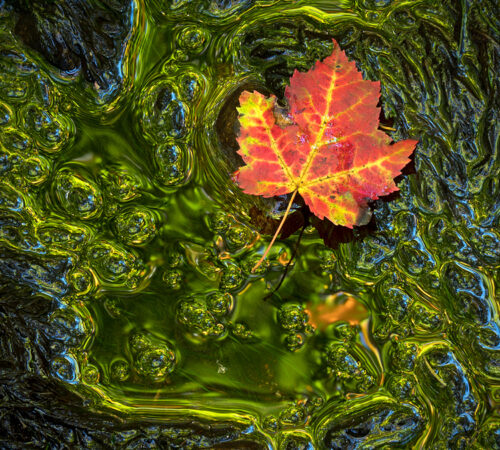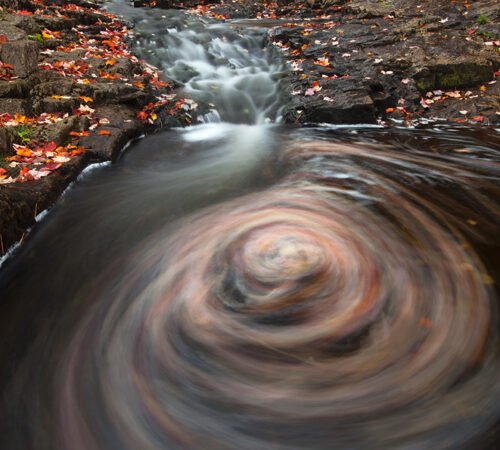A Slice of Color

Dear Bubbles:
You noted that for web use [of your photographs], you change the color space to sRGB. What color space are using for your TIF files? And why?
~Shirley
Dear Shirley,
Correct, the photos I share online, all JPEGs, in are in sRGB format. I save my TIFs (which you may recall is the format I use to save my master file from whence all my output—print and web—derives in my earlier post Process on Processing) in Adobe RGB format. To explain why I’ve made these choices, let me back up a bit.
sRGB and Adobe RGB are considered “color spaces.” As the name implies, a color space defines a range of colors that can be displayed on a screen, on a piece of paper, in a photograph, etc. Think of it as a set of instructions for translating colors from one output to another so that the colors you see appear consistently from device to device (e.g. from your camera to your screen and in your prints).
CMYK, which stands for “cyan, magenta, yellow, and key” (the latter referring to black), was one of the earliest color models used in the color printing process. It was established in 1906. Since this color space directs printing equipment how to render colors accurately on paper and other substrates, which are reflective, it employs a subtractive process. This means colors are subtracted from white light to yield a specific color. For example, on the color spectrum, cyan is the opposite of red so when red is subtracted from white light, it renders cyan (and vice versa). Magenta is the opposite of green. Yellow is the opposite of blue. If you subtract, cyan, magenta, and yellow from white light, you get an imperfect black (more of a dark, dark grey…). This four-color process is still considered the standard profile for color reproduction in printed materials like brochures, calendars, magazines, books, and more.
Then came the Digital Age in the late 20th century…
Digital devices (like computer monitors) project light out of darkness, so they used an additive, not a subtractive, process to display light and color. In other words, CMYK was unusable on a screen. As computers became more mainstream, technology companies like Apple, Microsoft, Hewlett-Packard, and Adobe sat down to knock out a new industry standard for color reproduction for digital devices. Not surprisingly, no one could agree on what that standard should look like, though, until 1996, when Microsoft and Hewlett-Packard set forth sRGB, which stands for “standard Red Green Blue.” The sRGB color space adds red, green, and blue together to create a gamut of colors on a screen. Some people often associate the “s” in sRGB with the word “screen” for this reason.
There was only one issue with this new color space. A digital device couldn’t display as many colors as seen in print output. In attempt to render the broad gamut CMYK offered but on digital devices using RGB, Adobe came up with its own answer in 1998 and called it—you guessed it—Adobe RGB (1998), or just Adobe RGB.
sRGB and Adobe RGB offer up the same number of possible color combinations (255 reds x 255 greens x 255 blues = 16.7 million colors if you’re into the math), but Adobe RGB offers a broader color gamut than sRGB (especially in the cyan and blue tones). According to the International Commission on Illumination (or the Commission internationale de l’éclairage, or CIE), sRGB can only display 35% of visible colors. Adobe RGB encompasses more than 50% of visible colors. Because of this, sRGB has also earned the nickname “small RGB.”
Kodak thought they could do one better than that so they created an even broader color space called ProPhoto RGB. The CIE suggests this color space includes over 90% of visible colors. It’s so big that it also includes imaginary and non-visible colors. (Which makes no sense to me, but I’m sure math is involved somehow. But that’s it, I’m making up my own color space. Introducing the Bubbles RGB! It’s the first ever color space made up entirely of imaginary and non-visible colors! If only you could see it!)
All that said, most, if not all, digital cameras have only two color space setting options: sRGB and Adobe RGB. Every camera I’ve come across thus far defaults to sRGB. I’m guessing this is because most people photographing today only use their images in digital form—they don’t actually print them.
If you are photographing in JPEG format and have no intentions of printing your image, sRGB setting will offer the most accurate and consistent way of displaying colors from your camera to your computer monitor, mobile devices, the internet/social media, etc. If you plan to print your photos (or at least wish to preserve that option for yourself), switch into Adobe RGB to start with a broader set of colors. Should you wish to share electronically, you can always change the color profile to sRGB in processing software later. Think of it this way: Adobe RGB is a whole pie. sRGB is a slice of pie. You can cut many pieces of pie from a single pie, but you cannot recreate a full pie out of a slice of pie. Mmmmmm pie…
If you’re photographing in RAW format, the color space setting is ignored. Whether it’s set to sRGB or Adobe RGB is irrelevant. Adjusting the color space in camera does not affect the data your camera sensor collects during the exposure. (For more on how this works, visit my earlier post on Restoring Balance.) Instead, you’ll assign your desired color space in either the Adobe Raw Converter or in Lightroom during the export process.
Now, no matter what color space you select in processing software, you’ll notice the colors on your screen won’t look any different from color space to color space. Remember—and this is where it gets confusing—your screen can only display sRGB even if you process your images in Adobe RGB, ProPhoto RGB, or one of the other profiles listed in Adobe’s exhaustive list under the Color Space pulldown menu. If/when you go to print that photograph, the printer will use whatever color space you assign as its instructions. If you use third-party printers, it’s always a good practice to ask your printer if they have their own custom color profile available for download. Otherwise the translation from your computer to their printer may not line up, and your colors may look way off in the final print. Similarly, if you accidentally share a photograph in Adobe RGB format on Facebook, for example, you’ll see a noticeable color shift.
I set my color space to Adobe RGB (1998) in the RAW file conversion process and save my master TIF file in Adobe RGB. It gives me a broad enough color spectrum to print my photographs with accurate color reproduction without having to go through additional conversion steps (like ProPhoto RGB, which none of my printing services use). In other words, Adobe RGB is easy, convenient, and does the job. When I wish to post online, I’ll save a JPEG from this master file in sRGB format to ensure the colors match up properly online. When I aim to print my photos in my books, I save my photo as CMYK.
When it comes to choosing a color space, it’s important to ask yourself how you plan to display your photographs. If you aren’t sure, I’d suggest starting with Adobe RGB to give yourself the most options. More pie is always better. Because of course it is!
Be well, be wild,
~Bubbles




